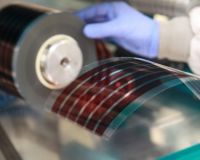



Feature Story
More feature stories by year:
2024
2023
2022
2021
2020
2019
2018
2017
2016
2015
2014
2013
2012
2011
2010
2009
2008
2007
2006
2005
2004
2003
2002
2001
2000
1999
1998
 Return to: 2017 Feature Stories
Return to: 2017 Feature Stories
CLIENT: CAMBRIOS
Mar. 31, 2017: OPE Journal
 CSEM Brasil, an institute for applied science and technology based in Belo Horizonte, Brazil, its spin-off company SUNEW, and Cambrios Advanced Materials (headquartered in Sunnyvale, California) have announced at LOPEC 2017 that they have jointly developed “OPV Power Film” that uses Cambrios’ ClearOhm technology to make transparent solar cells which will be integrated into windows and make use of the large areas available to produce power in buildings.
CSEM Brasil, an institute for applied science and technology based in Belo Horizonte, Brazil, its spin-off company SUNEW, and Cambrios Advanced Materials (headquartered in Sunnyvale, California) have announced at LOPEC 2017 that they have jointly developed “OPV Power Film” that uses Cambrios’ ClearOhm technology to make transparent solar cells which will be integrated into windows and make use of the large areas available to produce power in buildings.
CSEM Brasil showcased a prototype of large area OPV Power Film using silver nanowires applied to a glass window during LOPEC. OPV Power Film will be manufactured and sold by SUNEW, which was formed in 2015 to create the world’s largest facility to manufacture OPV and revolutionise the solar industry in Brazil and worldwide.
The vision of net zero energy buildings (nZEB) requires that each building generates all the power it consumes. For this to be a reality it is not enough to use solar on just the rooftops of buildings but rather solar cells must also be integrated with the facades and windows of buildings. Traditional technologies such as silicon panels are heavy and cannot be easily integrated on the walls. Organic photovoltaics (OPV) are the best option for building integration due to their intrinsic characteristics as they are highly flexible, lightweight, and is available in many colors offering beautiful aesthetics. OPV is a good example of organic electronics ability to use large-area low-cost roll-to-roll printing which is very scalable to large volume production with low carbon footprint and low cost.
Commercial buildings are increasingly using glass facades and over 10bn m2 of flat glass were produced in 2016 with 70% going into facades. OPV Power Film is designed to easily integrate into the glass facades.
“OPV Power Film is a big step in fulfilling our vision of energy everywhere and to bring solar energy generation close to where it is consumed in urban areas. Cambrios’ invisible electrodes are key to making transparent OPV films a reality” said Tiago Alves, CEO of CSEM Brasil and Chairman of SUNEW. “Cambrios is delighted to collaborate with CSEM Brasil and SUNEW to develop new breakthrough products to address the huge BIPV market” said John LeMoncheck, president and CEO of Cambrios Advanced Materials.
Moreover, Cambrios Advanced Materials announced that it has established a subsidiary in China. Cambrios Advanced Materials China will provide close support to customers using silver nanowires for touch sensors as well as new applications like solar cells. Eventually CAM China will also manufacture silver nanowire inks; this second production site will be closer to customers in Asia and will provide business continuity in case unforeseen circumstances interrupt production at the existing manufacturing site in Sunnyvale.
“My goal is to quickly set up an experienced team in China to provide top notch support to our customers and help them go to production with products like flexible displays and solar cells using ClearOhm silver nanowire technology,” said CC Hsiao, who will serve as CAM China president and CEO.
Return to: 2017 Feature Stories